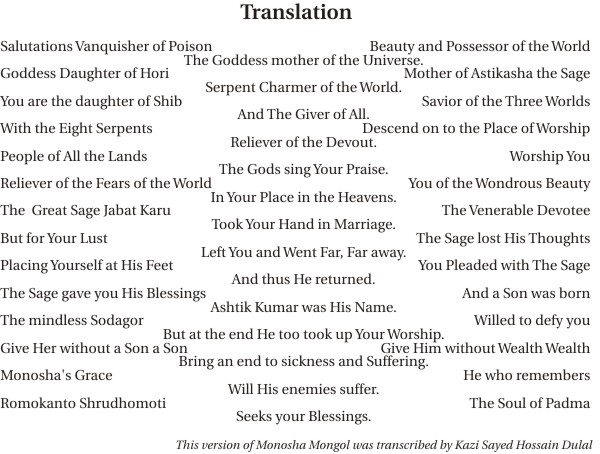| Story
Monosha Mongol
Saba El Kabir
 IF one was to look, one would find quite a few versions of the famed verses of Monsha Mongol, but a single, definitive version would be much harder to locate. Of course, when it comes to products of the folk traditions of the land, traditions that lives and breathes in the performances of the Charan (folk) poets, it is perhaps somewhat imprudent to search for absolutes. After all, we are not talking about inert, isolated art, manifest on lifeless reels of film or paper. These are art forms that are manifest in the very lives of the Charan poets, art that is produced and consumed in chorus. IF one was to look, one would find quite a few versions of the famed verses of Monsha Mongol, but a single, definitive version would be much harder to locate. Of course, when it comes to products of the folk traditions of the land, traditions that lives and breathes in the performances of the Charan (folk) poets, it is perhaps somewhat imprudent to search for absolutes. After all, we are not talking about inert, isolated art, manifest on lifeless reels of film or paper. These are art forms that are manifest in the very lives of the Charan poets, art that is produced and consumed in chorus.
But with the ways of these Charan poets under increasing pressure, we are running a very real risk of losing large chunks of irreplaceable traditions. Kazi Sayed Hossain Dulal, an eminent drama researcher, spent 11 years researching the pala (play) of Monosha Mongol, and transcribing the verses from the performances of these Charan poets and artistes. In this segment, week by week, we will present Monsha Mongol in its entirety, as transcribed by Kazi Sayed Hossain Dulal.
The Monsha (Serpent) Debi is a Hindu deity, is worshipped mainly for good fortune, prevention and cure of snake bites, and for prosperity and fertility. Traditionally, Manosha Puja in Bangladesh starts on the last day of Shrabon and lasts until the third day of Bhadra. However, Monoshar Pala is performed throughout the year, albeit in different forms and guises in different regions of the country. In Tangail, this is referred to as Bhasan Jaatra, and is performed as such: a jaatra with fixed characters and dialogue and musical interludes. In Kushtia, it is called Padma's Nachon, and is much more song and dance based. In the southern parts of the country, it is called Royan, in Ponchogor : Paddabati, in Dinajpur: Dishohori, and in greater Rajshahi region: Monsha Mongol.
The Monsha Mongol kabba (epic poem) consists of seven chapters. It tells the tale of Monsha Debi, her birth, her expulsion from the heavens, her struggle to establish her place as a deity, and her eventual triumph. In this issue, we present the Monsha Bondona, a hymn that traditionally starts off the pala of Monsha Mongol.
The Hymn of Monosha
Pronomoho Bishohori Bissharupa Bisshoshori
Tumi Debi Jagatjanani
Tumi Debi Horosuta Astikasha Munir Mata
Nagmata Bhubon Mohini.
Tumi Shiber Nondini Tribhubon Uddharini
Jogonidrajog Sonatoni.
Aushtanag Shonge Loye Pujasthane Nam Giye
Seboker Nishtar karini
Choturmukhe Projapoti Tomake Koren Stuti
Stobo Koren Joto Debgon.
Bhobobhoy Nistaroni Tumi Tritara Harini
Ashorete koro odhisthan
Mohamuni Jabat Karu Shadhok Jonab Guru
She Tomake Bibaha Korilo.
Holo Tobo Iccharongo Muni Holo Stobo Bhongo
Toma Taagi Katadur Gelo.
Munir Chorone Dhori Rakhilo Binosh Kori
Punorupi Firiya Ashilo
Muni Toma Dile Bor Jonmolek Putrobor
Ashtik Kumar Nam Holo.
Obodh Je Sodagore Tor Shonge Bad kore
Obosheshe Loylo Shoron
Oputrike Putro Dao Odhonike Dhon Dao
Rok Shok Koro Bimochon
Monoshar Shricharon Je jon kore shoron
Tar Shotru Name je Khoy
Romokanto Shrudhomoti Podmar Chorone Goti
Chirokal Rangapod Chai.

Copyright
(R) thedailystar.net 2009
|
